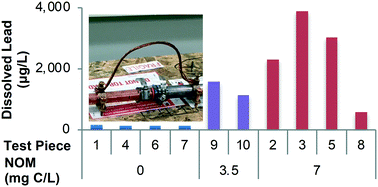Role of natural organic matter and hardness on lead release from galvanic corrosion†
Abstract
Lead release into drinking water from lead service lines, lead containing solder and plumbing fixtures continues to challenge many utilities. Corrosion inhibitors such as orthophosphate are often added to water to mitigate lead release, but their use may not be feasible for many utilities and may not be sufficient to meet regulatory limits. Thus, there is a need to identify other treatment strategies to minimize lead release. Two possible means that have not been thoroughly studied include natural organic matter (NOM) removal and hardness adjustment (e.g., water softening). Accordingly, this study employed a two-level fractional factorial design to investigate the role of NOM and hardness in conjunction with dissolved inorganic carbon (DIC), and pH, on the galvanic corrosion of lead. This study followed a “dump and fill” protocol and employed test pieces consisting of new lead and copper pipes with an external galvanic connection. Suwannee River NOM (SRNOM) increased the release of dissolved lead by an order of magnitude in collected water samples. To be precise, average dissolved lead release in the synthetic waters with and without SRNOM was 140 and 2460 μg L−1 respectively (potentially significant [i.e., 0.05 < p < 0.1]; p = 0.060). Using fluorescence excitation emission matrices, it was found that the release of dissolved lead was correlated to decreases in the NOM humic-like peaks A (R2 = 0.85; p = 4.4 × 10−8) and C (R2 = 0.87; p = 1.3 × 10−8). It is plausible that the decrease in fluorescence was due to the quenching effect of lead–NOM complexation, providing evidence that complexation mobilized dissolved lead. Hardness and DIC did not have a significant effect on lead release, however the galvanic current between the lead and copper pipes was 28.5 μA higher when the DIC concentration was 80 mg L−1 compared to 10 mg L−1 (potentially significant; p = 0.051). Finally, average total lead release at a pH of 7 was 7190 μg L−1 compared to only 2800 μg L−1 at a pH of 8.5 (potentially significant; p = 0.089), and there was some indication that the impact of SRNOM was lower at a higher pH.

- This article is part of the themed collections: Recent Open Access Articles and Best Papers 2022 – Environmental Science: Water Research & Technology


 Please wait while we load your content...
Please wait while we load your content...